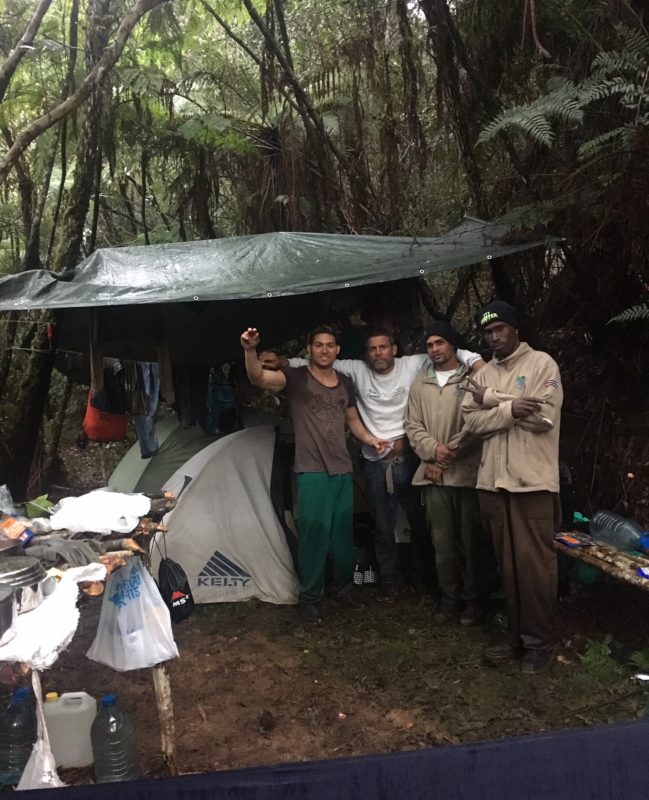
Team VCE-BIOECO in their Bayamesa base camp “kitchen” at 1500 m elevation. From left: Jose Ramon Fuentes, Jorge Tamayo (aka Yiyin), Amaurys Rapado Cruzata, and Yunier Caignet (aka Fiis), 30 January 2019./ © Chris Rimmer
Move over, Erik Ekman. The next generation of pioneering naturalists on Cuba has arrived. OK, that may be an overstatement, but VCE’s recent expedition to the remote Sierra Maestra found an intrepid VCE-BIOECO team on ground that may never have been touched by human feet! Our quest to unravel the overwinter distribution and habitat use of Bicknell’s Thrush (BITH) in eastern Cuba took an adventurous twist in 2019, as we sought to penetrate deep into the trailless mountains of 24,000-hectare Parque Nacional Bayamesa. Our BIOECO partners had forayed as far as existing trails could carry them last February, finding upwards of 15 BITH in the park’s high-elevation cloud forests. With most of this spectacularly rugged, pristine range still unexplored, we decided that a dose of VCE’s “brute force biology” was in order.
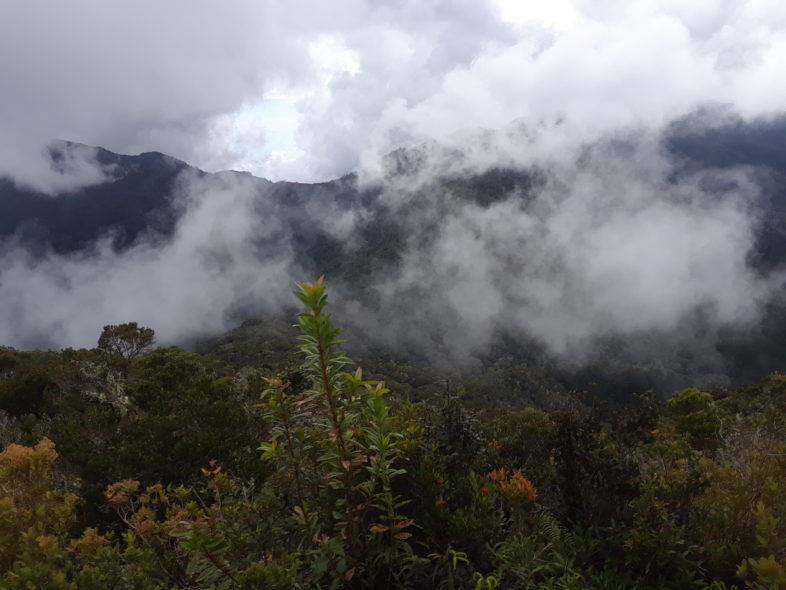
Clouds swirl across the remote southern peaks of Parque Nacional Bayamesa, a true untrammeled wilderness in Cuba’s eastern Sierra Maestra. / © Chris Rimmer
Our goal was simple: explore the park’s most remote areas south of Pico Bayamesa, at 1765 m the endpoint of trails. Specifically, we hoped to reach two peaks—Pico Maceo and Pico Maximo Gomez—that, as far as anyone can determine, have never been visited by humans. If any part of the Sierra Maestra harbored a motherlode of overwintering BITH (which we hadn’t yet found in the Pico Turquino or Pico Botella areas of Sierra Maestra), this untrammeled wilderness of virgin cloud forest seemed like our best bet. So it was that on 24 January, five of us shouldered heavy backpacks, laden with a week’s worth of food, camping and field gear, and plodded resolutely upslope to set up base camp 12 km away. A 2 pm start—later than we’d planned—had us huffing, puffing and donning headlamps four hours later. Trudging on until 7:30, our bodies (and appetites) finally rebelled. We made impromptu camp in the pine forest, a few km short of our destination. Instant mashed potatoes and freeze-dried spaghetti never tasted so good…
Reaching base camp below Pico Bayamesa by noon the next morning, we set up our 3 tents and “kitchen”, bolted lunch (dry soda crackers and canned tuna, washed by strong, heavily sweetened coffee), and got to work. Our daily ritual over the next week involved pre-dawn slogs 1.5 km straight uphill to the summit, whereupon machetes came out and trail blazing literally began. We divided into two teams, one wielding machetes, the other (including yours truly) armed with binoculars, playback units and field notebooks. Our arrival just happened to coincide with passage of a prolonged cold front, which made international news via a deadly tornado in Havana and brought us 4 straight days of chilly, wet weather. Treacherous footing on the steep slopes hampered our progress, while soaked vegetation made working with machetes a dangerous proposition. Our goal of reaching even the closer peak (Maceo) quickly became out of reach, though we did manage to forge ~2.5 km of new trail, snaking through a dense understory of tree ferns and epiphyte-laden saplings.
Forbidden from wielding a machete myself, I concentrated on ornithological pursuits, surveying for BITH at every opportunity and running 12 mist nets on Pico Bayamesa as we waited for each day’s new section of trail to open up. Although this was my third trip to Sierra Maestra’s highest elevations, I was captivated as always by the avian endemics. Cuban Solitaires and Cuban Trogons were never out of earshot, and one simply can not tire of their songs. Cuban Todies (one of 5 tody species, all endemic to the Greater Antilles) rattled and scolded frequently, while curious bands of Oriente Warblers sputtered and squeaked, often approaching closely. Great Lizard-Cuckoos broke out in occasional guttural bursts, and we were never far from a vocal Red-legged Thrush. Opening our 12 mist nets whenever the rain and swirling clouds allowed, we managed to capture many of these species (todies and trogons being our big “miss”), affixing uniquely-numbered Cuban bands to their legs.
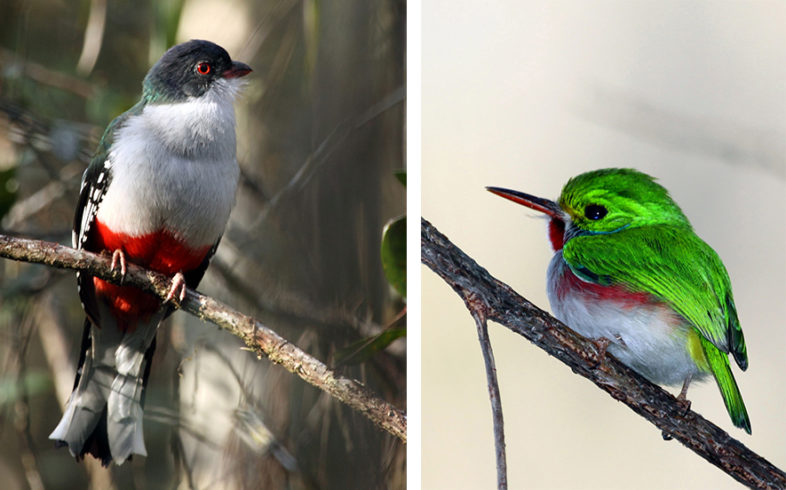
Two signature Cuban cloud forest endemics: Cuban Trogon (left) and Cuban Tody (right)./ © Nicasio Vina Davila
And, we encountered several familiar North American migrants. Most common were Black-throated Blue Warblers (6 of 33 birds we mist-netted were BTBWs) and every one we saw or captured was a female. American Redstarts and Black-and-white Warblers were also reasonably common, with smaller numbers of Cape Mays and Northern Parulas. A surprise for all of us was the capture of 3 Swainson’s Warblers in our nets. This species, which breeds in the southeastern U.S., is apparently regular on Cuba, but none of my local colleagues had ever laid eyes on one.
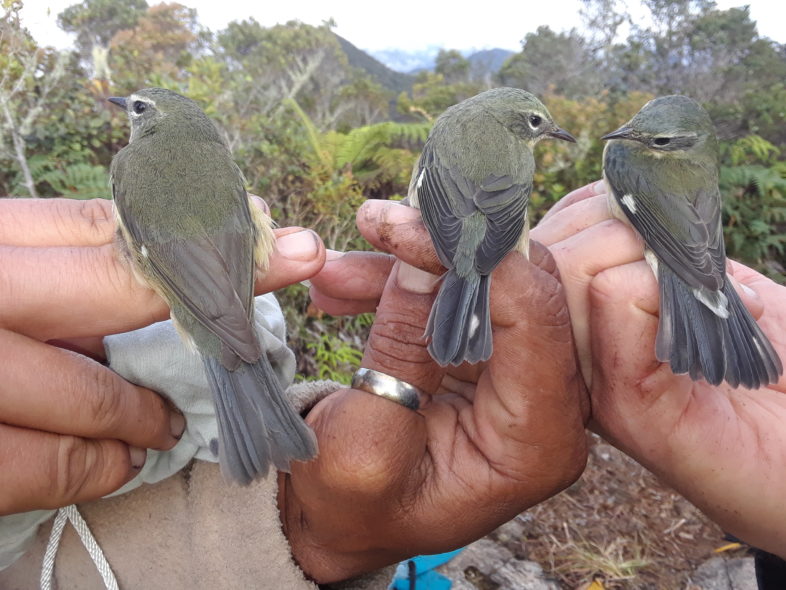
A trio of banded female Black-throated Blue Warblers on Pico Bayamesa, 29 January 2019. /© Jorge Tamayo
And, of course, we found BITH—not many, only 7 individuals in fact, but Bayamesa clearly provides important overwinter habitat for the species on Cuba. We managed to mist net and band 3 birds, all of which were full adults (ASYs, or after second-year birds in banding lingo) and almost certainly males. This matches our findings from Hispaniola, where BITH exhibit sexual habitat segregation, as males predominate in pristine cloud forests, females in lower-elevation, more disturbed rain forests. Interestingly, we found fewer than half the number of BITH that our BIECO colleagues detected last February, despite covering some of the same ground. As is so often the case with this elusive and enigmatic bird, our Bayamesa trip raised as many questions as it answered about the overwinter status of BITH on Cuba. It seems clear, however, after three winters of surveys that the island does not harbor a motherlode of BITH anywhere near to Hispaniola’s, despite what appears to our eyes like an abundance of suitable, intact cloud forest habitat. Fortunately, these protected areas are in remarkably good shape, unlike those in most of the DR and Haiti, where the majority of BITH overwinter. We can only wish Hispaniola offered the species similar habitat security (we’re working on it)!
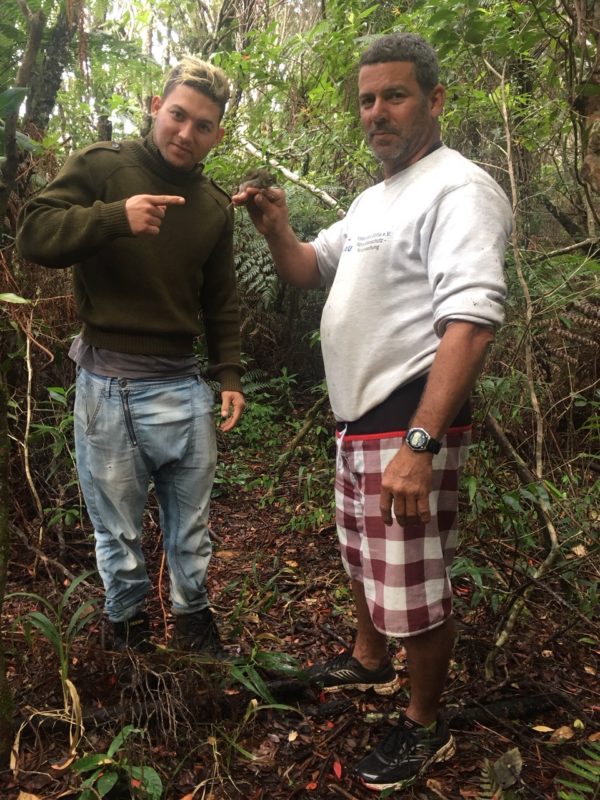
VCE’s BIOECO partners Jose Ramon Fuentes left) and Jorge Tamayo (right) with a banded Bicknell’s Thrush at the base of Pico Bayamesa, 31 January 2019./ © Chris Rimmer
Despite some frustration over our inability to penetrate as deep into Bayamesa as hoped, and more than a few moments of discomfort (e.g., wet boots for 5 straight days…), my 4 Cuban colleagues and I were completely taken in by our experience. Our hardships were eclipsed hands-down by the rewards of being the only humans—possibly ever—in this montane wilderness, immersed in its majestic virgin cloud forests. We enjoyed one another’s company immensely, shared a barrage of banter and laughs, and felt a palpable sense of exploration. My gut continues to tell me that Cuba harbors more BITH—in more places—than it has so far revealed to us, and that it trails only Hispaniola in importance as an overwintering refuge for the species. As I write this, our BIOECO colleagues are continuing to conduct BITH surveys in some “non-traditional” habitats outside Sierra Maestra. I’m eager to hear from them and will share their additional findings soon.
Oh, and Erik Ekman? No one need worry in the slightest about my diminishing his unvarnished legacy as a ground-breaking explorer on Cuba. Ekman’s pioneering botanical exploits >100 years ago were surely far more arduous than ours, though I doubt any less exhilarating—logistics and equipment alone, not to mention technology, are vastly different nowadays. But, we likely experienced some of the same thrills that come from exploring uncharted ground. I have to wonder if perhaps BITH were more densely packed into Sierra Maestra’s cloud forests a century ago. We’ll never know, but it is heartening that these mountains today offer such a secure overwinter refuge for a species that is truly beleaguered elsewhere in its restricted winter range.
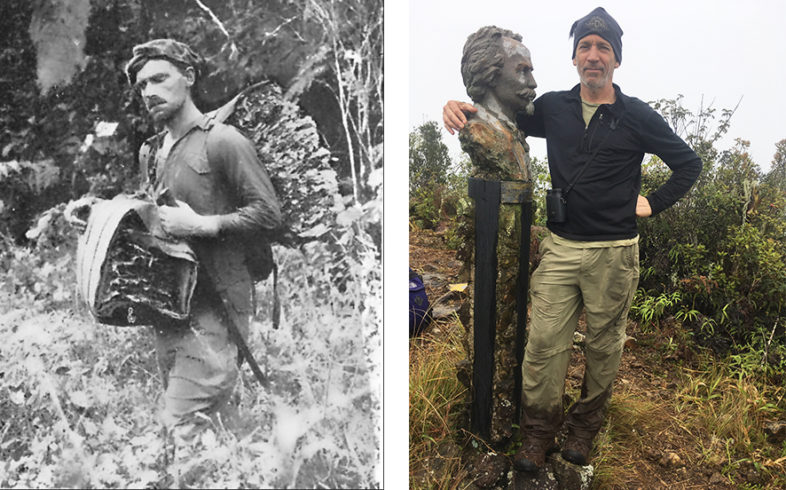
Two grizzled naturalist-explorers on Cuba, nearly a century apart. Left: legendary Swedish botanist Eric Ekman in the Dominican Republic, 1929-30./ Photographer unknown. Right: bedraggled VCE “brute force biologist” with bust of Cuban mid-1880s revolutionary hero Carlos Manuel de Céspedes, summit of Pico Bayamesa, 30 January 2019./ © Jorge Tamayo
Stay tuned for Part 2 of VCE’s 2019 Cuba expedition to Parque Nacional Humboldt. Our work in Cuba during the past three winters has been generously funded by Canadian Wildlife Service, the Wendling Fund, and several individual donors.

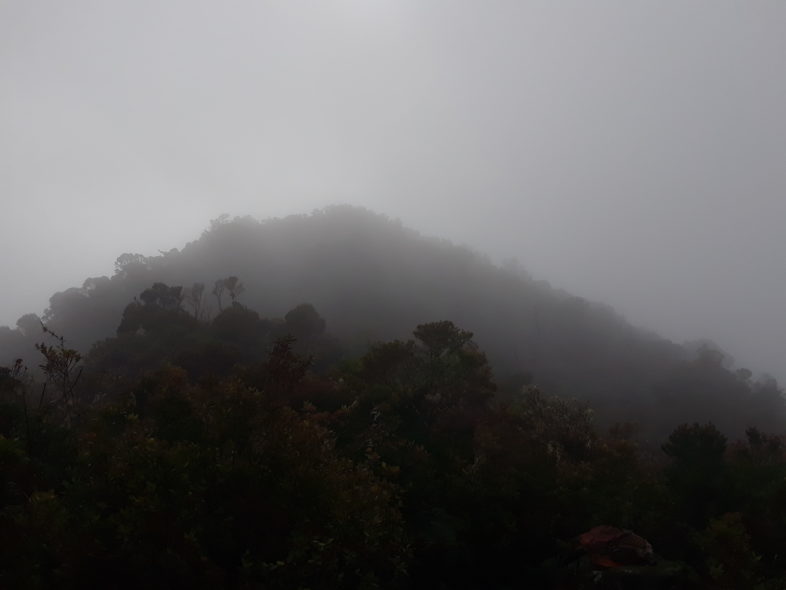

good work Chris
Here’s hoping you get your machete license soon, Chris!
Fascinating article, Chris. You are an indefatigable explorer. I admire you for spending your life pursuing your passion for birds and the environment. Thank you for your hard work.